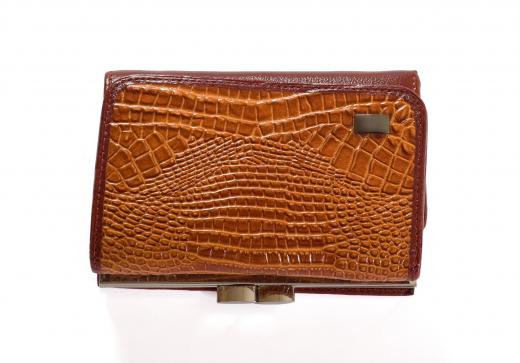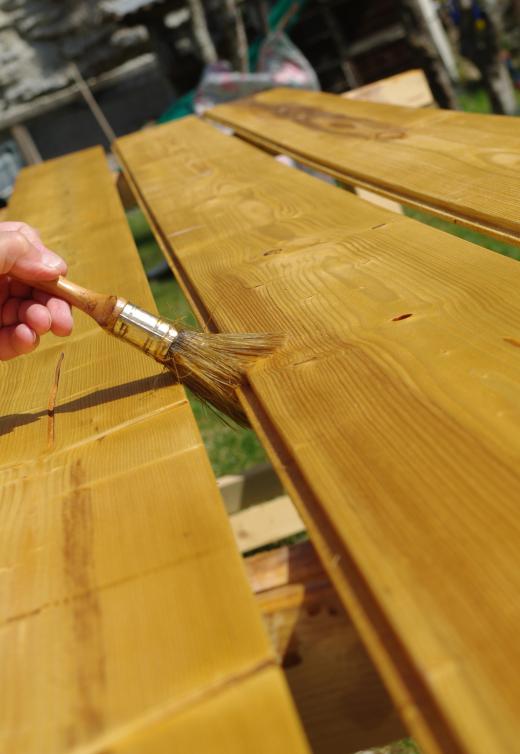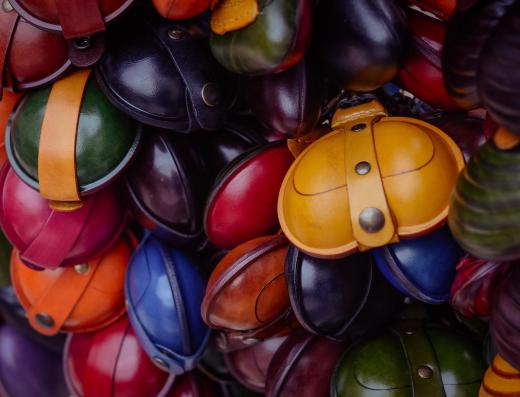What is Aniline Dye?
Aniline dye is a substance used to color fabric, leather, and wood. Like many technological breakthroughs, its discovery was accidental. These dyes are considered synthetic organic compounds, a carbon-based chemical that is altered by another substance, or synthesized. They come in a variety of colors, and are known for their clarity.
Mauvine, the first aniline dye, was discovered by 18-year-old William Henry Perkin. He was trying to create a synthetic version of the anti-malaria drug quinine on a challenge given by his professor in 1856. Perkin oxidized the chemical aniline, a coal-tar byproduct, with the chemical potassium dichromate. This reaction caused a thick black substance to form in Perkin's flask, which is a common symptom of a failed experiment in organic chemistry. Later, when Perkin was cleaning his flask, he found that the substance dissolved in alcohol to form a purple liquid, which was later found to take to textiles extremely well.

Aniline dyes come in a variety of colors, ranging from soft hues to bright primary colors. They are used in a variety of fields, but are most commonly found in the leather and woodworking industries. Aniline wood dyes are often hailed as having an advantage over wood stains for their clarity and saturation. They do not leave pigmentation on the surface of the wood, and purportedly leave the finished product less “muddy” in appearance. Not only does aniline wood stain leave no pigmentation behind, but it penetrates all parts of the wood equally, unlike stains that absorb more color into parts of the surface that are more porous.

Similarly, leather dyed with these substances does not lose any structure or grain pattern, and is often considered to be of a higher quality than other types of dyed leather. There are several different processes in which leather can be colored, each with its own advantages and disadvantages. Dyed hides may vary widely in quality. Many people dye their own hides using commercially available dye solutions, which are readily available in most leather supply stores or craft shops.

Commercially available aniline dyes are available in the form of powders that can be dissolved in either water, alcohol or oil. Each type has its own safety precautions, mixing procedures, and application processes, and users should always follow the manufacturer's instructions when using these dyes for any projects. Some forms are considered toxic, and proper safety precautions should be observed when using them.
AS FEATURED ON:
AS FEATURED ON:














Discussion Comments
@Yournamehere: Lacquer works great over aniline dye.
Can you please inform me where I can obtain these dyes in Australia? -- Eric G.
What are the best tips for dyeing wood with aniline dye? I saw an aniline-dyed wood table at my friend's house the other day, and now I really want to refinish an old table that I've been hanging onto.
So how do I go about dyeing wood with aniline? Is there any special equipment that I need, or can I just do it kind of like staining wood?
I was looking into leather dyes for my art class, and I was really surprised to see how well aniline works for leather dye.
It's one of those things that you don't really think about, but any really nice leather is likely to be aniline-dyed.
And did you know that there's actually different classifications of aniline dye, when it comes to leather?
Just like you have nubuck or antiqued leather, you also have aniline leather, but it can be pure aniline, protected aniline, or semi-aniline.
Pure aniline is just what it sounds like, leather that has been dyed with aniline, but hasn't had any smoothing pigments used on it, so there are color differences, and it still shows the scratches and scars that usually come with natural leather.
Protected aniline is leather that has been aniline-dyed, but has also been pigmented to keep the color consistent, and also has a clear protective topcoat, which makes it last longer.
Finally, semi-aniline leather is the middle ground between pure aniline and protected aniline; it still has a little bit of pigment and protection, but the natural flaws of the leather are still allowed to show through.
So there's your textile lesson for the day! Next time you're buying leather, you can impress the salesman with your knowledge of aniline dyeing techniques.
If you use an aniline dye for wood furniture, what finish should you put on over it? I love the way that aniline looks, but I'm really inexperienced with finishing wood, and have no idea what I would put on after it.
Varnish? Something else entirely? I really have no idea, does anybody reading this know more about dyeing furniture than I do? I would really appreciate it!
This article was very useful for a report I'm writing on aniline dyes. Thank you very much!
Post your comments